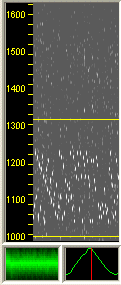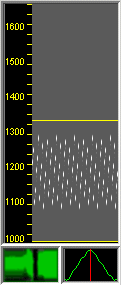This is a computer program for Amateur Radio transmission and reception using a computer and HF radio transceiver.
The program provides computer chat-mode operation on the HF bands, using a sound card technique
to generate and modulate for transmission using tones at audio frequency, and receive and decode the incoming signals,
also at audio frequency. An SSB transceiver translates these signals to and from the HF Amateur Bands. The DominoEX
mode is a development from earlier experimental DominoF and DominoG programs, but is not compatible with them.
This version (DominoEXFEC V2.0) is compatible with earlier ZL2AFP DominoEX versions, and also with
MULTIPSK, with and without FEC.
DominoEX operates using a variation of the MFSK technique (MFSK = Multiple Frequency Shift Keying), since
MFSK offers very good immunity to interference and ionospheric effects, and is also very sensitive. However,
MFSK can be quite difficult to tune in, and suffers from some interference effects, which are usually masked by using error correction. This unique program addresses these limitations in a special
way that wipes away all problems. DominoEX is easy to use, and hence ideal for beginners. You will be impressed with the performance!
MFSK is a respected and mature technique, a generalized form of FSK (FSK = Frequency Shift Keying).
FSK and MFSK modes enjoy good immunity to noise and do not require a linear transmitter.
MFSK modes were first developed in the 1950s and 1960s. The best known of these modes were
Piccolo and Coquelet.
An earlier experimental design by ZL1BPU and ZL2AFP, DominoF (with two sets of 8 interleaved tones) was in many ways most similar to Coquelet. The new DominoEX mode uses just one tone set, and has a more effective and efficient technique for tackling propagation effects.
DominoEX was specially designed for use on 80m at night, and to be easy for beginners to operate. The techniques used give independence from tuning and drift problems, and reception performance is so robust that error correction
is generally not required. As a result the mode is quick to tune, very 'slick' (quick change from TX to RX) and has a high typing speed.
This ZL2AFP DominoEX version has optional (and automatic) Forward Error Correction (FEC). This mode is very robust, and FEC is not normally required. It can be helpful for
ensuring that file transfers are accurate, especially under conditions of erratic lightning interference or severe multipath effects,
but it does add delay and slows down data transfer.
In these documents, DominoEX means the operating mode in general terms, while ZL2AFP DominoEX
specifically implies this ZL2AFP DominoEX program.



 It is very important for digital modes to be easily recognised and identified.
Thus the onus is on the designer to provide something unique for each new mode.
Of course MFSK modes can be easily separated from other modes by their musical sound. The most common MFSK modes are:
It is very important for digital modes to be easily recognised and identified.
Thus the onus is on the designer to provide something unique for each new mode.
Of course MFSK modes can be easily separated from other modes by their musical sound. The most common MFSK modes are: